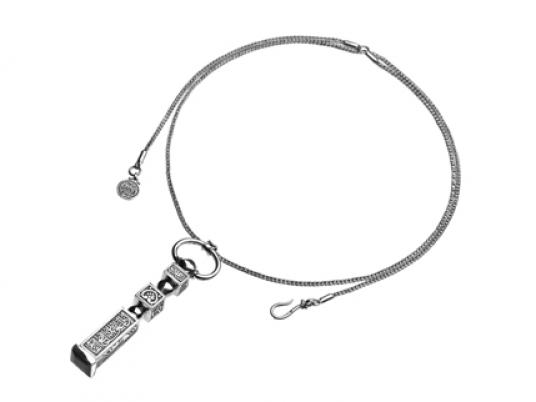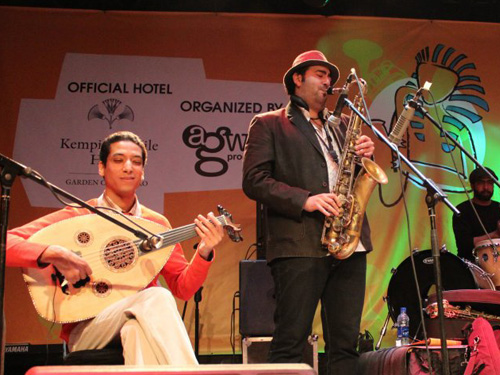The press release for the Egyptian Independent Artist Music and Film Festival — organized by Darb 1718, Ganoub Studio and the Cairo Jazz Club Agency — made so many impressive claims they almost began to cancel each other out in the buzz.
There was the political, that the revolution has already “terminated” the old regime; the artistic, promising a “new breed of art for a new promising Egypt;” the superfluous, calling Egypt a “national leader” (can it lead itself?) in the promotion and support of independent music. All this was a tribute to Ahmed Bassiouny, the artist, experimental musician and teacher who was killed in the first days of the 25 January revolution.
Loosely reflecting Bassiouny's career interests, the lineup combined music, film and contemporary art. The challenge of events with mixed art forms is that they must simultaneously handle not only completely different conditions of presentation and engagement, but also they understand the broader assumptions of each art form, which often goes beyond the event's dominant festivity. Most difficult of all is not to position the art forms so they must compete for attention.
On this occasion the music, served by a state of the art stage and highly competent engineers, fought and won by a mile. Under a warm full moon and couched blissfully on beanbags, the young, affluent crowd was introduced to Rami Abadir and PolyMorph's retro electronica; the bands CairoKee, SimpleXity and Feed Me; and the launch of Machine Eat Man's “Egyptronica.” Out of these, the stand-out performance came from Machine Eat Man, whose pretty, melodic loops were overlaid by powerful electro and live unison drums structured into concise themes and climaxes. The set finished with a short theremin solo, which will hopefully be used more in future performances.
Assured as it was, it was hard to discern anything specifically “Egyptian” from Machine Eat Man's sound. It was tronica for sure, but not yet “Egypt," particularly when electronic strains of sha'abi music might make a decidedly more authentic claim on Egyptian electro. Rami Abadir's solo performance, developed in the last year since his departure from the band Dusk, seemed still exploring his devotion to the progressive sounds of Camel and Pink Floyd. A nascent sense of humor emerged midway through the set as Abadir explored TV-pulp and space-age effects, but it is unclear whether he will go beyond pastiche.
A break in the musical program made room for four short films with little to link them in theme, introduction or style. Due to the ambient light of the courtyard, the darker films suffered badly, and being on the small side screen they were implicitly reduced to the same status as the VJ-style mashups that the electronic musicians make as a visual distraction for their sets. The poignancy of “David,” a simple documentary about an orphaned Ugandan footballer by Mohamed Soliman and Angela Buhr was lost in the crowd’s chatter. However, Mahmoud Hamdi's “The Man Who Wanted to Play Drums,” an animation that reworked footage from Tom McCarthy's “The Visitor” excited curiosity. Overall, both the musicians and the filmmakers tended toward retro and generic approaches.
The exhibition space revealed that the art component of the festival was the current Darb 1718 exhibition — a video selection from the Malian biennial Bamako Rencontres de Photographie — extended for another couple of weeks. The project addresses the major need for African and African diaspora works to circulate within the continent. Andrew Esiebo's photo essay video, developed as a project over the last five years, discusses the complex realities of black African male homosexuality in Europe. Rana ElNemr's three-screen installation Olympic Garden is a meditative photographic research-based study of the site of near-anomie that was created between the Olympic Center in New Maadi and Arab Al-Basateen in Cairo. Because the audio of the piece was impossible to hear, the precise purpose of the festival was unclear. How did an Africa-based biennial, conceived, researched and curated in wildly different circumstances in Egypt, become redefined as a post-revolutionary festivity overnight? The show itself is enormously important, yet its casual reframing under unrelated impulses undermines both the artworks and the festival's proclamations.
A tribute is an act of kindness, and perhaps this is all it that should be taken in this case; but it is also an invitation to think closely about a person's contribution. A more fitting tribute to Ahmed Bassiouny might start with supporting experimentalism — his chosen style — and afflicting the comfortable with humor and a critical eye.
Still, once you clear away unfulfilled claims, the Egyptian Independent Artist Music and Film Festival was a good concert, with some films and an opportunity to see a valid exhibition that happens to be ongoing. In coming years, to see this become a focused platform for the same emerging experimental media artists that Bassiouny worked so hard to support, would be extremely exciting. That, however, might need a far more inventive and researched format than this festival, which cannot easily cope with the cross-disciplinary platform it was trying to celebrate. And, with regards to both the intentions of some of the pieces, as well as the state of “post-revolutionary Egypt,” it becomes problematic for “celebration” to be culture’s only allotted role.
But there was the crowd, in the “new,” perfectly democratic Egypt (let's forget about emergency law for now), witnessing a “new breed of art” (the current exhibition extended), watching young musicians being “supported” in an event (where they didn't get paid), celebrating an “experimental” artist (by not being experimental). Culture's power to express and redraw reality is part of its revolutionary potential, but why go through all that effort when the press release can do all the work?




